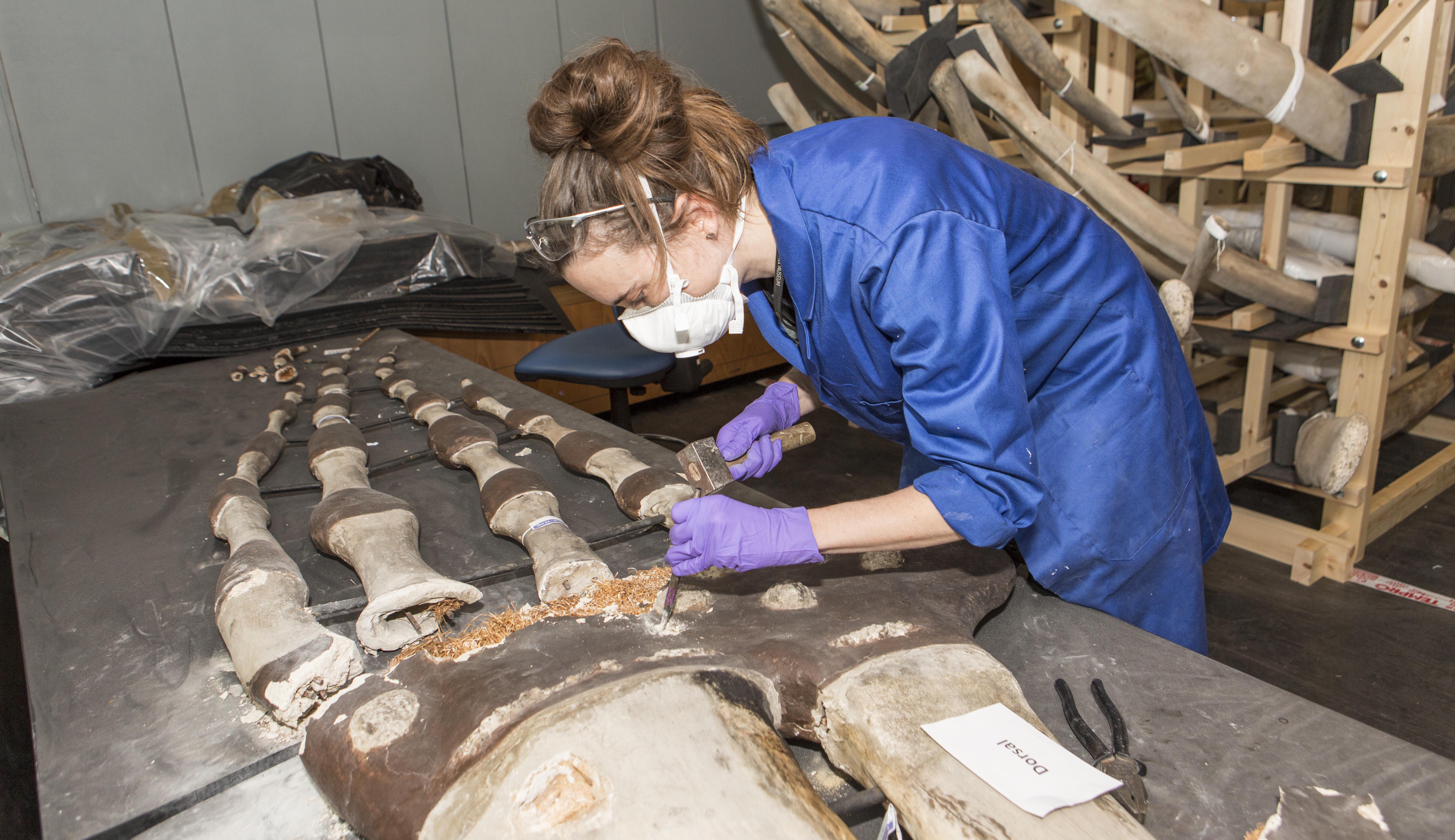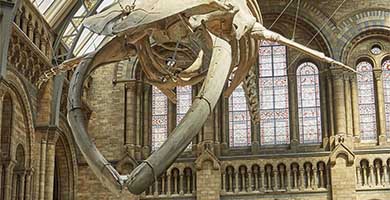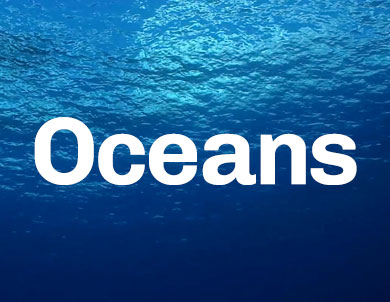Scanning and 3D-modelling the skeleton of a blue whale is an enormous undertaking.
Dr Farah Ahmed, Head of Imaging at the Museum, explains how technology helps our understanding of the largest animal on the planet.

The full blue whale skeleton
Scanning and 3D-modelling the skeleton of a blue whale is an enormous undertaking.
Dr Farah Ahmed, Head of Imaging at the Museum, explains how technology helps our understanding of the largest animal on the planet.
Relocating the blue whale skeleton from the rafters of the Mammals gallery to a dramatic new posture in Hintze Hall requires many hands and a range of expertise.
Along the way, the skeleton will not only be cleaned and conserved, but also laser-scanned and 3D-modelled for scientific posterity. Scientists will then use this data to make a 3D print of the whale.
For Farah, the relocation of the whale is a rare opportunity to share such an important specimen with the world.
'It is the only chance we will get to scan a blue whale and capture that information before it's suspended in Hintze Hall indefinitely,' she says.
'Creating a digital copy of the whale offers a way to capture and share data about the specimen, which could be of great value to science and education.'

A Museum conservator works on a blue whale flipper
3D modelling can help researchers gain a nuanced understanding of large animals like blue whales, which are difficult to observe in the wild.
'For example, if you wanted to understand how a whale manages to open and close its immense jaws with all the pressure of the ocean,' Farah explains, '3D data could help scientists interested in biomechanics to model and better understand the effect of those forces.'
In addition to the full 3D surface scan, Computerised Tomography (CT) scans of the last eight vertebrae will provide vital internal information for scientists seeking to understand how blue whales move through the water.
Having a highly detailed scan also greatly helps the work of conservators at the Museum.
Farah adds, 'Where the naked eye might miss some very fine details, a scan could inform the conservation team of practical work that needs to be done before it becomes a bigger problem.'
As scanning technology becomes more mobile, it is increasingly easier for the Museum to capture and share detailed digital renders of specimens. Still, the blue whale's size and complexity presented an exciting logistical challenge for Farah and her team.
'We had only six weeks to scan the whale and everything had to be done alongside conservation within a very tight time frame,' Farah explained. 'With objects as large and complex as a whale, it can't come to you - you have to go to the whale.'

Conservators set up a pop-up conservation studio to house parts of the huge skeleton
Two imaging specialists, Brett Clark and Kate Burton, were brought in to work on the project.
Farah says, 'We used mobile, handheld laser scanners and scanners on fixed arms to capture the profile of the surface, including any cracks, peaks, troughs and texture, and we will put it all back together in a 3D digital representation.'
The majority of the scanning took place in a pop-up conservation lab and storeroom at the Museum, but the huge skull had to be taken off-site.
In the Museum basement, a 3D-imaging specialist was hard at work in Farah's lab, carefully adding shadows and textures to each individual rib of the whale.
'You have to have creativity and imagination to process this kind of data. It takes the whole package - an understanding of science and artistic flair in order to digitise a big blue whale.'
It took more than six months to complete the full 3D render of the skeleton.
The surface scan data can also be used to print a 3D model of the whale in resin.
3D printing creates solid objects from a digital file. For the whale, each bone was printed separately and assembled by Museum scientists.
This method is invaluable because it is much easier for the team to make tweaks on a scale model than on the large original.

Museum staff finesse the presentation of the blue whale in Hintze Hall using a 3D model.
According to Farah, virtual reality will be an important next step for both the Museum and science in general.
'Surface scans lend themselves to very exciting work with virtual reality and that's really where I see them having the most extensive use in the future,' she said.
'People of all ages can engage with these kinds of models. Both children and adults might enjoy the virtual reality aspect, and professors and scientists might draw on them for biomechanical studies and modelling.
'It really gives us a vehicle to engage everybody in some way, which is quite cool.'
The Museum has already captured thousands of specimens through surface scanning, and requests for this kind of data keep flooding in.
While laser scanning lends itself well to large, still structures like skeletons, however, it can't be done for every kind of specimen. For instance, it isn't suited to capturing the surface of anything shiny, furry or wet - therefore a large number of the Museum's collections.
When complete, the blue whale skeleton will join the ranks of other 3D models made by the Museum, including Dippy the Diplodocus.

Visit the Museum and walk beneath the largest animal ever to have lived.

Find out more about why we need to protect the oceans, find themed events, and read about the pioneering work of the Museum's marine scientists.

Just how weird can the natural world be?
Don't miss a thing
Receive email updates about our news, science, exhibitions, events, products, services and fundraising activities. We may occasionally include third-party content from our corporate partners and other museums. We will not share your personal details with these third parties. You must be over the age of 13. Privacy notice.
Follow us on social media